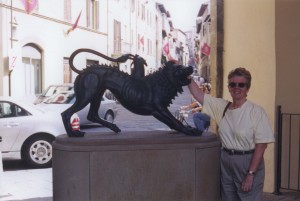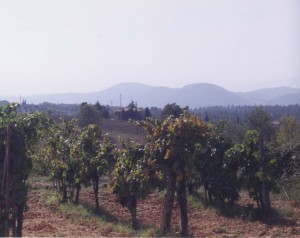The Mysterious Etruscans

Dinner at the Locanda Rosati is a convivial affair. As the lights of the Umbrian town of Orvieto twinkle across the valley, the guests all gather at one large table in the kitchen to dine on favorite family fare. The conversation is wide ranging, but when at last I mention my purpose for being there, researching the Etruscans for a book I am writing, attention turns to that.
“Mysterioso,” one guest opines. Another wonders whether much of the world uncovered by archaeology isn’t the product of an alien race.
The Etruscans are the subject of many interesting theories, and always have been. A Dominican Friar, Annius of Veterbo, writing in the fifteenth century, declared that the Etruscan language was related to Aramaic, and that the Etruscans themselves had helped Noah repopulate the earth after the Flood. While scientifically unsound, his theory did serve some useful purpose, preventing, for a time at least, the Church from destroying anything Etruscan as a pagan symbol. The Etruscans could have used another Annius a century later when tons of Etruscan bronzes were melted down to adorn a church in Rome.
Cosimo de Medici was another to use his own theory of the Etruscans to some purpose. He fancied himself an archaeologist and indeed is credited with finding and saving some truly magnificent Etruscan bronzes — the statue of the Orator, and the famous Chimera of Arezzo that was the inspiration for The Etruscan Chimera.
De Medici, intent in establishing political and economic control during his time, used the Etruscans for his own political purposes. He declared himself and other Florentines to be descendants of the Etruscans, and indeed his successor took the title Dux Magnus Etruscan, or great Etruscan leader.
 At a much later date, D.H. Lawrence, author of, among other books, Lady Chatterley’s Lover, traveled through Tuscany and declared the Etruscans to share his personal philosophy. Almost every stone he saw was a phallic symbol of some sort, and on very little evidence, he declared the Etruscans to be in touch with nature and their natural selves.
At a much later date, D.H. Lawrence, author of, among other books, Lady Chatterley’s Lover, traveled through Tuscany and declared the Etruscans to share his personal philosophy. Almost every stone he saw was a phallic symbol of some sort, and on very little evidence, he declared the Etruscans to be in touch with nature and their natural selves.
Despite all the rather extraordinary theories, in fact we know quite a bit about the Etruscans. Their language, which is non Indo-European, has more or less been deciphered. We know that people who lived in an area roughly bounded by the Tiber River in the south and east, the Arno River to the north, and the Tyrrhenian Sea to the west, shared a common language, beliefs and customs, lived in cities, mined rich metal deposits along the Tyrrhenian shore and used those to develop extensive trade networks by land and sea, and from about 700 BC until their defeat by Rome in the third century BC, dominated a large part of central Italy. Politically they were united in what is referred to as a Dodecapolis, a league of Twelve Cities, who met annually near Lake Bolsena for games and strategy.
During their heyday, before the birth of the Roman republic, there were Etruscan kings of Rome – the Tarquins – who were instrumental in building the great city that would ultimately defeat them. The last king of Rome was Tarquinius the Proud who was expelled from Rome in 509 BC. From that time on, the Etruscans and the Romans were enemies.
In the end, the Etruscan federation could not hold against the might of Rome. For whatever reasons the cities did not band together to protect themselves, and one by one they fell. Soon they were replaced, and in a way forgotten, although succeeding cities are some of the most beautiful in Italy — Orvieto, Arezzo, Perugia, Volterra. What were once fortified Etruscan cities are now the beautiful medieval hill towns of Italy.
